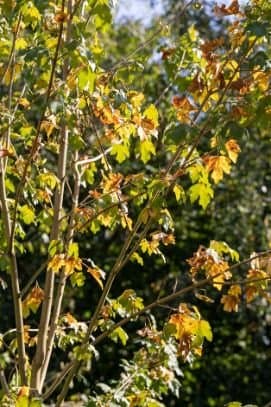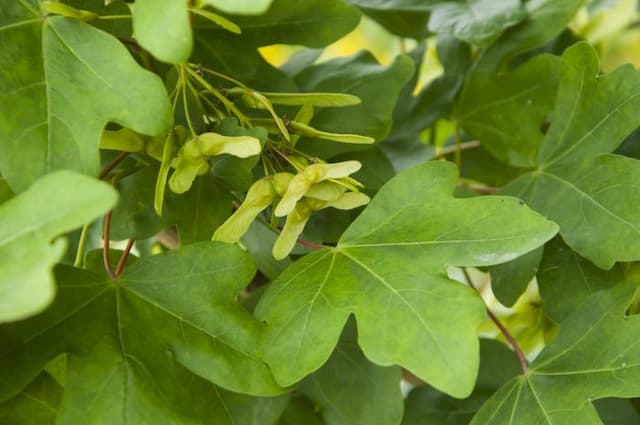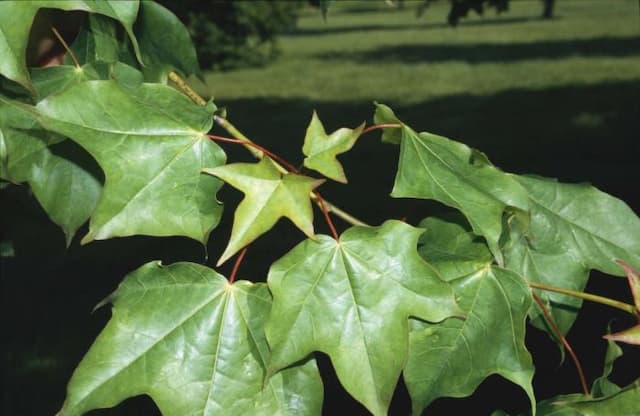Père David's maple Acer davidii

ABOUT
Acer davidii, commonly known as David's maple, is a striking deciduous tree known for its beautiful bark and foliage. David's maple has a distinctive bark that is smooth and green with vertical white stripes, giving it a snakeskin-like appearance. This interesting pattern on the bark is often more pronounced in the winter months, providing winter interest in the garden. The leaves of David's maple are shaped in a classic maple fashion, with three or sometimes five lobes, and a heart-shaped base. During spring and summer, the foliage is a vibrant green, turning into shades of bright yellow, orange, or red in the autumn, providing a brilliant display of fall color. Aside from its foliage and bark, David's maple produces small, inconspicuous flowers in spring. These flowers can be a pale yellow-green color. Following the flowering period, the tree bears winged seeds, typical of many maples, which are known as samaras. These seeds are paired and can often be seen twirling to the ground when they are released in the fall. Overall, David's maple is appreciated for its ornamental features, which include the eye-catching bark, the seasonal color changes of its foliage, and its overall graceful appearance. While it adds aesthetic appeal to a landscape, it doesn't overpower with its size, fitting well in various garden situations.
About this plant
 Names
NamesFamily
Sapindaceae
Synonyms
Père David's Maple, David Maple
Common names
Acer davidii subsp. grosseri, Acer grosseri, Acer hersii, Acer davidii var. grosseri.
 Toxicity
ToxicityTo humans
The plant Acer davidii, commonly known as David's maple, is not widely recognized for being poisonous to humans. There are no well-documented cases or significant reports of toxicity leading to poisoning upon ingestion of this plant. Therefore, it is generally considered safe from a toxicity standpoint, with no notable symptoms attributed to its ingestion. However, as with any plant, individual allergies or sensitivities may still exist, and it's always prudent to exercise caution and avoid ingesting plants that are not commonly used as food.
To pets
Acer davidii, known as David's maple, does not have a reputation for being toxic to pets such as dogs and cats. There is a lack of substantial evidence or specific reports indicating that this maple species presents a poisoning risk to household pets. Consequently, it is generally regarded as non-toxic, and there are no well-known symptoms that arise from pet consumption of this plant. However, pet owners should always remain vigilant and discourage their pets from eating ornamental plants, as individual animals may have unique sensitivities or allergic reactions.
 Characteristics
CharacteristicsLife cycle
Perennials
Foliage type
Deciduous
Color of leaves
Green
Flower color
Yellow
Height
20-30 feet (6-9 meters)
Spread
15-25 feet (4.5-7.5 meters)
Plant type
Tree
Hardiness zones
6
Native area
China
Benefits
 General Benefits
General Benefits- Aesthetic appeal: Acer davidii, commonly known as David Maple, has distinctive striated bark and attractive foliage that change colors with the seasons, adding visual interest to landscapes.
- Habitat for wildlife: The tree provides shelter and food for various bird species, insects, and other wildlife, helping to support local biodiversity.
- Shade and cooling: The canopy of David Maple offers shade, which can cool surrounding areas and reduce the need for air conditioning in nearby buildings.
- Erosion control: Its root system helps stabilize the soil, preventing erosion and improving water quality by filtering runoff.
- Ornamental use: Due to its unique appearance, the David Maple is often used in horticulture for ornamental purposes in parks, gardens, and as street trees.
- Seasonal interest: With its spring flowers, summer foliage, and autumn colors, David Maple provides year-round interest in temperate climates.
 Medical Properties
Medical PropertiesThis plant is not used for medical purposes.
 Air-purifying Qualities
Air-purifying QualitiesThis plant is not specifically known for air purifying qualities.
 Other Uses
Other Uses- Acer davidii, or David's maple, is sometimes used in furniture-making due to its attractive, finely textured wood that polishes well.
- The wood of David's maple can be used in turnery to create intricate wooden objects like bowls, handles, and ornaments.
- In landscape design, David's maple can be used as a focal point due to its striking bark and fall color.
- The tree can be planted along streets and in parks for its shade and ornamental value.
- Dried branches of David's maple may be used for decorative indoor arrangements or wreath-making.
- Some cultures use the seeds of David's maple in ornamental crafts and jewelry due to their unique shape and appearance.
- Young saplings of the David's maple can be trained into bonsai for the traditional Japanese art of miniature trees.
- The tree's bark has been used in some traditional crafts for its unique texture and pattern, such as in bark inlay work.
- Leaves of David's maple can be included in compost to enrich soil as they break down and add nutrients.
- In woodcraft, smaller branches might be fashioned into rustic walking sticks or canes.
Interesting Facts
 Feng Shui
Feng ShuiThe Père David's maple is not used in Feng Shui practice.
 Zodiac Sign Compitability
Zodiac Sign CompitabilityThe Père David's maple is not used in astrology practice.
 Plant Symbolism
Plant Symbolism- Strength: The Acer davidii, commonly known as David's maple, is recognized for its robust and sturdy nature, symbolizing the strength and endurance one possesses.
- Resilience: With its ability to withstand variations in climate and conditions, David's maple represents resilience and the capacity to persevere through challenges.
- Growth: As a tree that continuously grows and expands, David's maple symbolizes personal growth and the pursuit of one's development.
- Beauty: The attractive foliage and distinctive bark of David's maple highlight the beauty in the natural world, reminding us to appreciate the aesthetics in our surroundings.
- Adaptability: Given this maple's versatile nature and adaptation to different environments, it often represents the ability to adjust and thrive in various situations in life.
 Water
WaterFor the Père David's maple, during the growing season, it's important to maintain consistently moist soil; this may mean watering once or twice a week depending on weather conditions. Ensure you're providing deep watering to encourage root growth - this might translate to about 1 to 1.5 gallons for a small tree every week, adjusting for rain and temperature. During winter, reduce watering as the tree's growth slows down, monitoring the soil to prevent it from drying out completely. Over-watering can cause root rot, so always check the soil moisture before adding more water.
 Light
LightPère David's maple thrives in dappled sunlight or part shade, preferring protection from the harsh afternoon sun. A spot that mimics the lighting conditions of its natural woodland habitat, with morning sun followed by afternoon shade, is ideal for healthy growth.
 Temperature
TemperaturePère David's maple requires temperate conditions and does best in temperatures between 60°F and 80°F, which promote active growth. While it can withstand brief periods outside of this range, prolonged exposure to temperatures below 20°F or above 90°F may stress the tree. Ideal growing conditions include avoiding extreme temperature fluctuations.
 Pruning
PruningPrune Père David's maple to maintain its shape and remove any dead or diseased branches, which is best done during late winter or early spring before new growth starts. Thinning out crowded branches every few years allows for better air circulation and light penetration. The frequency of pruning can vary, but a general check and light maintenance can be done annually.
 Cleaning
CleaningAs needed
 Soil
SoilThe Snakebark Maple prefers a well-draining, fertile soil mix with a pH of 5.5 to 7.5. A blend of loamy soil, peat, and perlite or sand will create an ideal environment for root health and moisture retention.
 Repotting
RepottingSnakebark Maples, being medium to large trees, are not typically repotted like houseplants. They should be planted in a location where they can grow undisturbed, with space to accommodate their mature size.
 Humidity & Misting
Humidity & MistingSnakebark Maples do not require high humidity and can thrive in average outdoor conditions. They are adaptable to a wide range of humidity levels typical of temperate climates.
 Suitable locations
Suitable locationsIndoor
Ensure bright indirect light, cool temps, and air circulation.
Outdoor
Plant in moist, well-drained soil in partial shade.
Hardiness zone
6-9 USDA
 Life cycle
Life cycleAcer davidii, commonly known as David's maple, begins its life cycle with seed germination in the spring, after the stratification period which breaks the seed dormancy. The germinated seedling develops roots and shoots, emerging as a small sapling that relies on photosynthesis for growth. As the sapling matures, it grows into a juvenile tree, with its distinct snake-skin patterned bark becoming more pronounced. Once it reaches reproductive maturity, which can take several years, the tree produces small, inconspicuous yellow flowers in the spring that are pollinated by wind. Following pollination, the tree bears samaras, winged fruits that disperse with the wind in the autumn, ensuring the propagation of the species. The adult David's maple may continue to live for many decades, during which it will go through repeated cycles of growth, flowering, and fruiting.
 Propogation
PropogationPropogation time
Spring-Early Summer
Propogation: The most popular method of propagating Acer davidii, commonly known as David's maple, is by seed. The optimal time for sowing seeds of Acer davidii is in the fall, immediately after collection, as they exhibit a form of dormancy that is most easily broken by natural winter cold. To propagate by seed, collect the samaras as they change from green to brown but before they drop from the tree. Clean the winged fruits and sow them thinly in a cold frame or a sheltered outdoor seedbed. Cover the seeds with a light layer of soil and let the winter cold stratify them, which aids in breaking their dormancy. Germination will usually occur in the spring once temperatures rise. Alternatively, for spring sowing, the seeds need to be stratified in moist sand for about 90-120 days at 34-41 degrees Fahrenheit (1-5 degrees Celsius), simulating winter conditions.






![Freeman maple [Autumn Blaze]](/_next/image?url=https%3A%2F%2Fplants-admin.emdemapps.com%2Fimages%2Fplants%2F%2Fimages%2F604b575b84d87.png&w=640&q=75)


